Day 1 – Johannesburg
In Johannesburg be sure to visit the Apartheid Museum to learn about the history of South Africa’s system of racial segregation and the fight against it. Take a tour of the Soweto neighborhood, including a visit to Nelson Mandela’s former residence.
To see and learn more about Johannesburg, you could take a Red Bus Tour. This is a great way to explore Johannesburg safely, reliably and in comfort from the top deck of an open-top bus. Learn about the history of gold mining, hear stories of apartheid history and understand the triumph of modern Johannesburg while listening to the on-board audio commentary, available in 15 languages. This tour stops at all top sites in and around Johannesburg allowing you to explore the economic powerhouse of Africa, easily and safely.
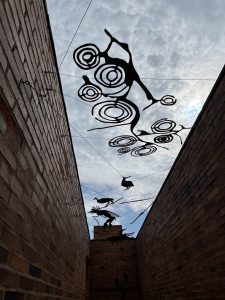
Day 2 – Predator World & Craft Market
Visit Predator World, home to over 320 species of animals. Located in the Pilanesberg area, 8 minutes from Sun City. They offer an opportunity to see many of Africa’s predatory species at close quarters. Qualified, knowledgeable guides share interesting information on each animal, while child-friendly tours include treasure hunts, refreshments and fun activities. You’ll get up close and personal with Lions, Cheetahs, Leopards, Hyenas, Tigers and more. And if you’re lucky, you just might get to play with baby tigers or lions.
Another must-see place to visit is a Craft Market where visitors can experience the vibrancy and warmth of the African continent. These markets offer beautiful hand-made products from South Africa, as well as from other parts of Africa. A wide range of ornaments, bead work, handbags, décor items, paintings, animal skins and gifting products are showcased in an African hub, bringing together tourists, shoppers and traders.

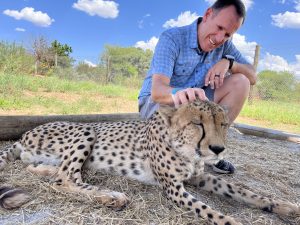
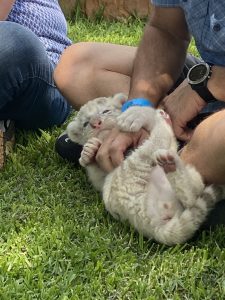
Day 3 – The Monkey & Elephant Sanctuary
At the Bushbaby Sanctuary, situated west of Hartbeespoort Dam alongside the Elephant sanctuary, you’ll be able to interact with several different monkey species. Your guide explains their behavior, habits, and diets while you feed them their favorite treats. Primates, such as squirrel, spider, capuchin monkeys and lemurs, are given a new lease on life at Monkey Sanctuary. The monkeys live in a wild world laden with waterfalls, lush vegetation, natural mountain springs and the chance to reside in as natural environment as possible. Their goal is to give them the opportunity to live as they would in the wild.
After spending time with the monkeys, you’ll head to the elephant sanctuary where you’ll get to observe these gentle giants up close. Learn about the different elephant families in the sanctuary and their unique personalities. You also get to feed them and if you’re lucky, watch them take a mud bath, a favorite activity of these intelligent creatures.
After you’ve seen the monkeys and elephants you might want to take a walk through the Johannesburg Botanical Garden, which is close by. This garden features an attractive mix of bunched indigenous and exotics surrounded by lawns, overlooking the 7,5-hectare Emmarentia Dam, which dates back to the turn of the century, popular with canoeists and boaters. There is also a tea pergola for meetings, shows and exhibitions. There’s a dam that is fed by two smaller dams above it, which are home to many aquatic birds.
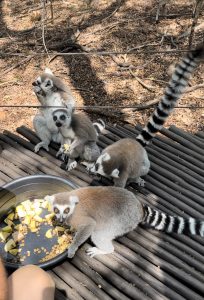
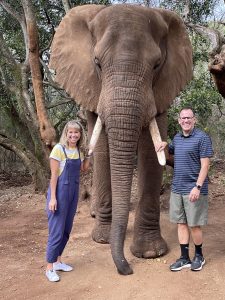
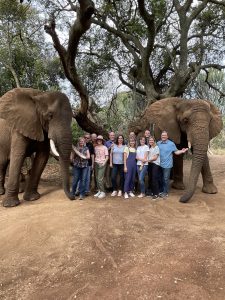
Day 4 & 5 – Kruger National Park
This National Park is one of the largest game reserves in Africa and is home to a wide range of wildlife, including the Big Five (lion, leopard, elephant, rhinoceros, and Cape buffalo) and the Crazy Eight (Big Five plus hippo, giraffe and wild dogs). We were lucky enough to see the all Crazy Eight when we were there in late October 2022! Going on a game drive in Kruger National Park is an experience of a lifetime, and there are several options available for visitors.
Self-drive game drives: Visitors can drive themselves through the park and explore the different routes available. The roads are well-maintained and marked, and there are rest camps and picnic spots along the way. However, visitors are advised to stay on the designated roads and keep a safe distance from the animals.
Guided game drives: Visitors can also opt for guided game drives, which are led by experienced and knowledgeable guides who know the park and its animals intimately. Guided game drives can be taken in open vehicles, closed vehicles, or on foot, depending on the preference of the visitor. These drives are a great way to learn about the animals, their behavior, and their habitats.
Night drives: Kruger National Park also offers night drives, which are a unique and thrilling experience. Visitors can observe the nocturnal animals that are not easily seen during the day, such as hyenas, bushbabies, and owls. The night drives are conducted by experienced guides and are restricted to certain areas of the park.
Bush walks: For those who want a more immersive experience, Kruger National Park offers guided bush walks. Visitors can explore the park on foot, accompanied by an armed guide who provides information on the plants, animals, and birds found in the park. Bush walks are restricted to certain areas of the park and are conducted in small groups.
Visitors are advised to follow the park rules and regulations to ensure their safety and that of the animals. They should also carry binoculars, hats, sunscreen, and cameras to make the most of their game drive experience. Overall, a game drive in Kruger National Park is a must-do for anyone visiting South Africa, and it is an experience that will be cherished for a lifetime.


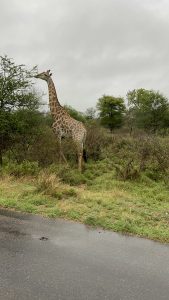
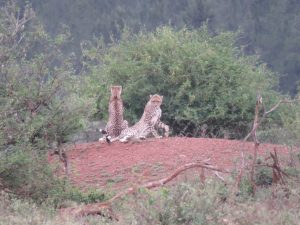
Day 6 – God’s Window & Alzu Petroport Rest Stop
God’s Window is a breathtaking natural wonder located in the Mpumalanga province of South Africa. It is a viewpoint located on the Drakensberg escarpment that offers panoramic views of the Lowveld region, stretching out as far as the Kruger National Park. The viewpoint is at an altitude of 1,800 meters above sea level and is known for its dramatic cliffs and lush vegetation. Visitors can gaze out over the misty valleys below and marvel at the cascading waterfalls and crystal-clear streams that wind their way through the landscape. God’s Window is also home to an abundance of bird and animal life, including baboons, bushbuck, and various species of birds. The area is surrounded by indigenous forest, and the fresh mountain air and tranquil surroundings make it a popular spot for hiking and picnicking.
The Alzu Petroport rest stop is much more than a typical petrol station, offering a range of facilities that make it a popular destination for travelers. One of its main attractions is the opportunity to see a variety of wild animals up close, including rhinos, ostriches, and antelope. The animals are housed in a specially designed enclosure, which can be viewed from a raised walkway or from the bathroom, providing a safe and comfortable viewing experience for visitors. The rest stop also features restaurants with a panoramic view of the animal enclosure, serving delicious meals and refreshments, as well as a large convenience store and gas station. Overall, the Alzu Petroport is a unique and unforgettable rest stop that combines convenience and entertainment, making it a must-visit for anyone traveling through South Africa.

Day 7 & 8 – Cape Town
Cape Town, South Africa, is a vibrant city with a rich cultural heritage, stunning natural beauty, and a variety of activities for visitors. Here’s a sample two-day itinerary of what to do in Cape Town
Start your first day at the iconic Table Mountain. Take the cable car to the top and enjoy breathtaking views of the city and the surrounding coastline. Next, head to the historic Robben Island, where Nelson Mandela was imprisoned for 27 years. Take a guided tour of the island and learn about its fascinating history.
In the afternoon, you could take a stroll through the colorful streets of the Bo-Kaap neighborhood. This neighborhood is famous for its brightly painted houses, cobblestone streets, and vibrant cultural heritage. End your day with a stunning sunset view at Signal Hill. Enjoy panoramic views of the city and the Atlantic Ocean as the sun sets over the horizon.
On your second day in Cape Town, start with a trip to Kirstenbosch Botanical Gardens, one of the most beautiful gardens in the world. Take a leisurely stroll through the gardens and marvel at the stunning array of flora and fauna.
You could then head to the nearby Constantia Wine Route, where you can enjoy wine tastings and tours of the historic vineyards or you could drive to the Cape of Good Hope, the southwestern tip of the African continent. Take a scenic drive along the coastline and marvel at the rugged beauty of the area. There’s the charming fishing village of Hout Bay, where you can enjoy fresh seafood and take a boat ride to Seal Island.

